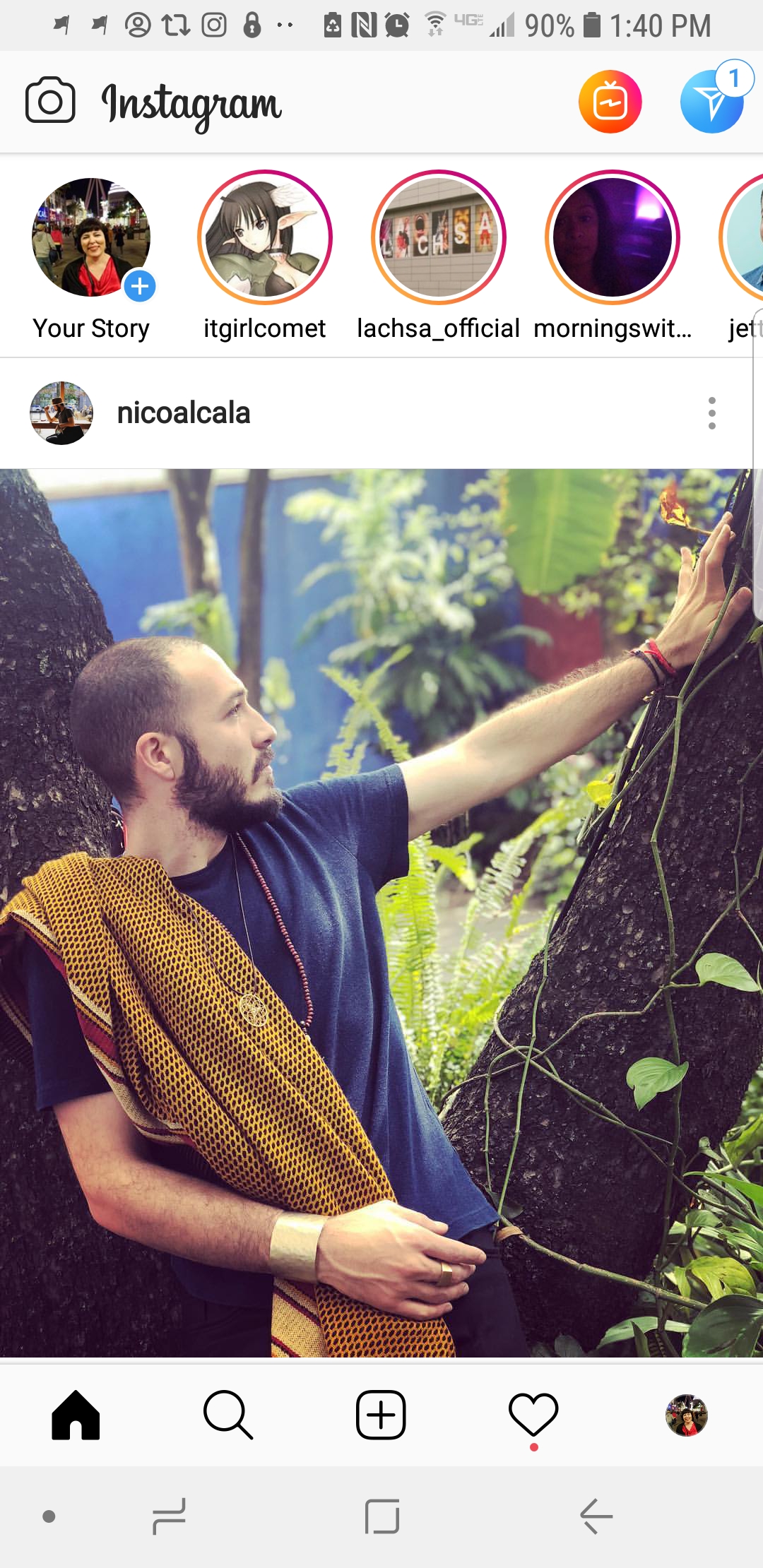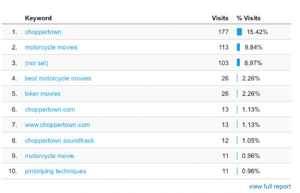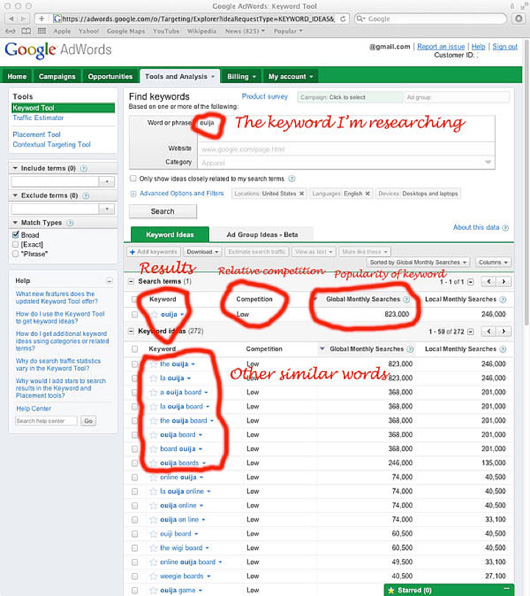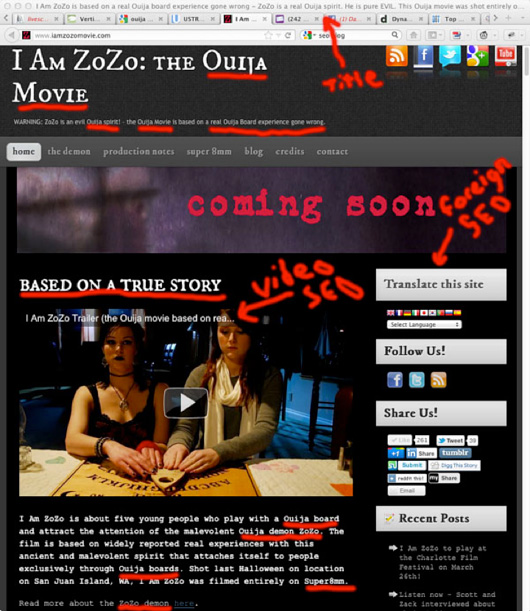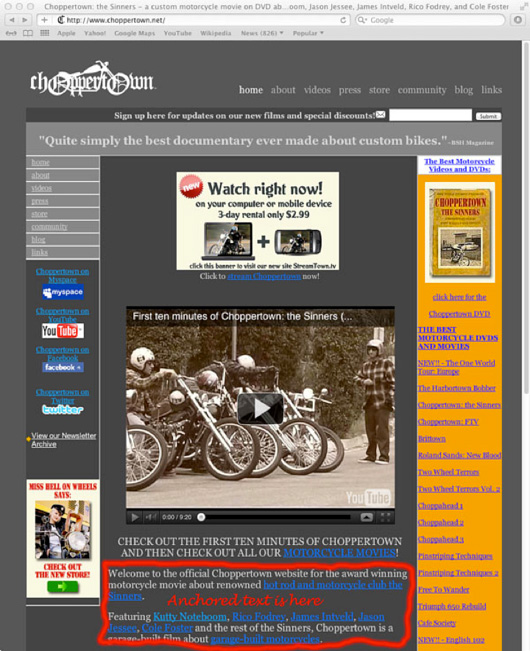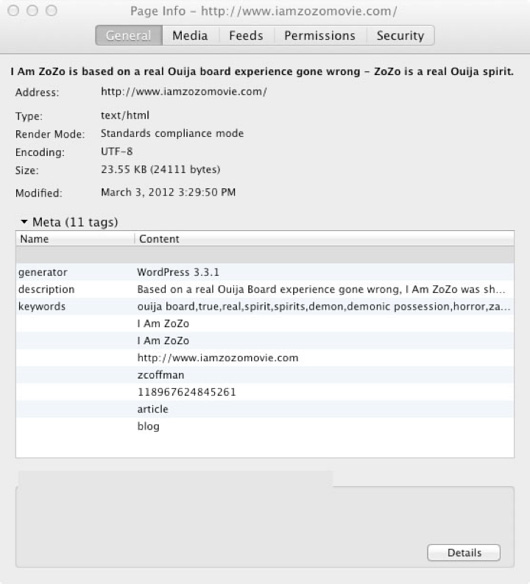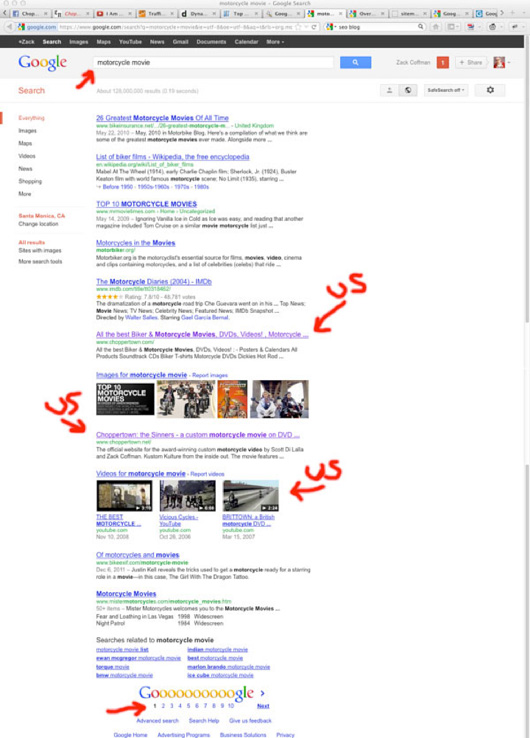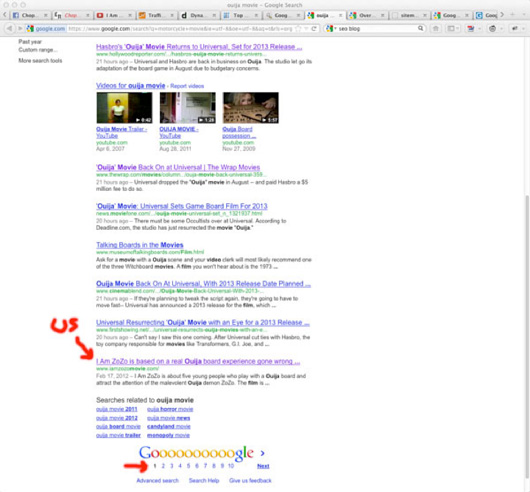
No advance+little marketing commitment=poor results
I used to be the resident regular blogger here at The Film Collaborative, but some of you may know, I’m wrapping up a law degree and I only weigh in on the blog periodically. My colleagues at TFC have been picking up the slack, and doing an awesome job of it, if I do say so. While I am writing only sporadically these days, sometimes I just have ideas that must be written. This post has been brewing in me for a while.
I have something to say and it will not be easy to accept for many of you. I write this out of love and the hope that it will save heartache down the line. Hope is prevalent in the film industry. It can be motivating, but also it can blind filmmakers to the realities they must face in the market. The market is now over saturated with film product and this is only going to continue. Mindsets that once may have worked for the majority now have to give way to a more productive, informed and aggressive one in order to see success.
One big lesson I learned in law school is how legal theories of a claim or case involve classification of law, elements, factors etc. Being precise and persuasive is the difference between winning and losing. I have thought about this lately in terms of filmmakers’ complaints when they have chosen to give their films to traditional distributors and then were unhappy with the results. Perhaps being precise with the production’s goals and persuasive in presenting how the film will sell in the market in order to meet those goals is something that filmmakers should be practicing.
I’m weary of hearing the irrational expectations of filmmakers who did not think about the business side of their film before they made it. I want filmmakers to actively get real about what’s possible in today’s marketplace and assert some ownership of the results of the performance of the film.
You all know me and know I’m the last person to just blindly defend a traditional distributor. But I have noticed a pattern now that I find hard to justify. Many filmmakers (maybe most!) are still wishing, hoping and resorting to making all rights deals with traditional distributors and then, if the release is not handled how the production envisioned, the distributor is blamed. With all the new tools, and by now, not even new discourse about direct distribution and how it gives filmmakers the ability to handle their own releases in the manner they envision, why are so few choosing that route? Is it easier to put the blame on an entity instead of taking the responsibility from the start? Is it easier to think that if a film is chosen for pick up by a distributor, it has merit and then when that merit doesn’t materialize in the market, it must have been the fault of the entity handling it?
Again, I have no issue blaming companies for being in breach because that can definitely happen. Distributors have lots of titles in their catalogs and each will not get the same amount of attention. They will not likely tell you that when signing a deal, but it will happen to some titles. What I do want to address is the filmmaker theory that the distributor screwed up without having any coherent evidence as to how and what would have happened otherwise to making the deal.
I think if a distributor offers you no advance or a small advance for all or even part of your rights, that’s a big vote of little confidence in the title. Doesn’t that sound logical to you? If you are signing that deal, truly believing there is going to be profit that will reach you beyond what the sales agent takes, what the distributor takes, what the platform/store/exhibitor takes, you’re dreaming. Little investment in acquiring the rights to your film means little marketing effort is going to be made, and likely little will result from the release for you. A filmmaker agreeing to that arrangement should be clued in as to how likely the film will succeed. Again, I am not speaking about being in breach of promises in writing such as projections and a marketing plan that is not actualized. If big projections were made based on a clear marketing plan presented in writing outlining all efforts that will be made, then not executed, there is reason for complaint.
I find it increasingly frustrating to talk with filmmakers who have little or no evidence of their own to demonstrate their film’s appeal. Why would a film that is not going to have an impact festival premiere, has low website traffic numbers, low social network following, small or no email list to contact fans be assumed to wildly succeed? If no one on the team has done the proper marketing work and/ or the film is not a hit with the audiences who have seen it (most likely at smaller festival screenings), why do filmmakers insist their film will succeed? The tea leaves are splayed out to be read and it may be a difficult read, but filmmakers cannot just brush them aside. If you choose to give your film away to a distributor for little or no advance and no serious marketing commitment (in writing), you should not be surprised by poor results.
3 pieces of advice you should take from this:
1. Prove your film’s concept with proper marketing preparation and act on its distribution directly, or;
2. Prove your film’s concept to an outside distributor and get all of your expectations and requirements as part of a written agreement so there are no surprises and you get what you bargained for, or;
3. Own the fact that you have no proof of your film’s appeal either directly or to middle man distributors and then, reconcile that if you sign a no or low advance, all rights deal with no serious marketing commitment , you have very low expectations for its success.
Filmmakers make some common business projection mistakes like comparing their films to two totally unrelated or uncomparable films; confuse festival circuit success with an indication that there will be home entertainment success, even though the two classes of distribution are entirely different; or their measurements and requirements of success are decided without knowing the costs associated with that success. I am encouraging more practical and realistic thinking. It’s okay sometimes if films don’t recoup their budgets. Films can be, and in my opinion should be, about art and cultural connection. But if the ultimate goal is to fully recoup and/or profit, a detailed plan from the start describing how that is going to happen and what it will realistically take to make that happen really needs to be in place. The complaining and blaming needs to stop.
Orly Ravid September 26th, 2013
Posted In: Distribution, DIY, Long Tail & Glut of Content
Tags: advance payments, complaining, film release, independent film distribution, Marketing, mindset change, Orly Ravid, success, The Film Collaborative
Distribution of transmedia stories
by Sheri Candler
Lately, we have been getting inquiries on distribution strategies for transmedia projects in the indie film space. While it is my distinct impression that most of these “transmedia” projects are really marketing campaigns built around films and this extra material probably would not have financial value to a traditional film distributor, I want to investigate a bit more on projects that have launched as cross platform stories.
My knowledge about the transmedia space is limited only to what I have read about or heard about through those who have created such projects. Most of these people were hired by studios, game designers, or big corporate brands to create an immersive and interactive story experience often using digital tools and sometimes real world events to sell a product (a film, a game, a TV show, a car, a book, a mobile service etc). Within the realm of those who create these story experiences, there is disagreement about what constitutes a “true” transmedia project. Is it actually transmedia if it serves “the mothership” product as a sales funnel? Is it actually transmedia if it raises awareness and encourages activism for a social cause? Is it actually transmedia if it breaks a story into a million (or less maybe) pieces and spreads it out in satisfying chunks across many different, but interconnected spaces, online and otherwise? Is it actually transmedia if it provides the audience with a way to participate or interact with the story, perhaps offering the ability to influence the story being told?
The wikipedia definition:
“Transmedia storytelling (also known as transmedia narrative or multiplatform storytelling or cross-media storytelling) is the technique of telling a single story or story experience across multiple platforms and formats using current digital technologies, and is not to be confused with traditional cross-platform media franchises, sequels or adaptations. From a production standpoint, it involves creating content that engages an audience using various techniques to permeate their daily lives. In order to achieve this engagement, a transmedia production will develop stories across multiple forms of media in order to deliver unique pieces of content in each channel. Importantly, these pieces of content are not only linked together (overtly or subtly), but are in narrative synchronization with each other.”
No mention of selling other products in this definition, but does it mean it can’t be used in that capacity? “Permeate their daily lives” is an interesting phrase though because it seems to suggest either bringing the story to life around the viewer or allowing the viewer to virtually, if not physically, step into a story being told or to have some life altering experience that would not have happened had they not encountered/participated in the story.
The man who coined the term Transmedia Storytelling, Professor Henry Jenkins, has offered his updated interpretation here.
Over the next few weeks, I will report back with case studies on what I have found through interviews with those who have been through the experience, launched projects into the world and lived to tell the tale. Also, I will review the newest book on the subject by Andrea Phillips called A Creator’s Guide to Transmedia Storytelling. Hopefully, I will find people who are willing to be open about the process and how they succeeded or what they learned for next time. This is a very experimental space where either a lot of money is spent by way of corporate marketing budgets that will only see a return through sales of a product (and usually do not ONLY use a transmedia experience to advertise that product); or through new media funds where there is no expectation of return or favorable outcome; or through very tiny, self funded budgets where producers are gaining experience and expressing their creative ideas while directly interacting with an audience.
Stay tuned…
Orly Ravid October 4th, 2012
Posted In: transmedia
Tags: A creator's guide to transmedia storytelling, Andrea Phillips, Case studies, cross platform, digital storytelling, distribution, Henry Jenkins, independent film, Marketing, multiplatform storytelling, storytelling, transmedia
SEO: Lifeblood of the Indie Filmmaker
This post was written by Zack Coffman, Co-founder and President of independent film company One World Studios Ltd.; a feature film production and distribution corporation in Los Angeles. It was originally published by The Film Collaborative (TFC) on the Sundance Artist Services blog.
As indie filmmakers, we often don’t have millions of marketing dollars (or any at all) to spend on turning our films’ titles into household names. Getting “organically” ranked highly by Google and other leading search engines is the single most cost-effective way to created a sustained marketing presence for your film.
SEO, or Search Engine Optimization, is akin to a dark art that every savvy website owner undertakes in an effort to get their site(s) ranked highly by Google, and to a lesser extent Bing and Yahoo. To be put in the top five most highly-ranked sites in a given category is the Holy Grail of SEO. Appearing “above the fold” before a Google user needs to scroll down to see more results gives the website a nearly priceless stamp of approval by Google’s secret algorithms and is worth hundreds if not thousands of times more than any kind of paid internet marketing, hence the steady stream of spam emails we all receive from SEO “gurus” promising to get you more highly-ranked for a big time fee. At the end of this article I’ll give you some great resources to get started on your own. Note: While it’s not our full-time gig, my company would also consider choice projects for SEO analysis on a limited case-by-case basis.
Most of what we’ve learned here at our indie film production and distribution outfit has been through hours and hours of internet research as well as even more hours spent trying different strategies on our own bevy of sites across our One World Studios Ltd. brands. That said, any SEO expert worth their salt will tell you that Google is constantly tweaking their ranking algorithms and introducing varied ways for sites to be tracked and ranked so what works one day may not work forever, thus making SEO truly a dark art! The following basic tenets have worked for us however, so let’s begin.
To start with:
Your domain name is the number one thing Google looks at when it starts to judge your worthiness and appropriately index your site. Many films use their title with “movie” or “-movie” after it so Google knows that it’s a film. You can get more creative if you like however if you think that people may search for your film with different words than the film’s title or if you have some kind of catchy phrase associated with your film that is more memorable than the title by itself. I’ll be using our sites as guinea pigs today so let’s start with our new Ouija movie, I Am ZoZo; a feature that we shot entirely on Super 8mm. For this film we registered the domain www.iamzozomovie.com and for our previous motorcycle movies a couple of our highly-ranking sites are www.choppertown.net and www.choppertown.com.
Now that you have a site to work with it’s important to set up Google Analytics and Google Webmaster Tools so you can be indexed properly and you can see how your traffic is reaching you, etc. allowing you to make changes and tweaks over time. Also, make sure you have an updated sitemap.xml file in your site’s root folder, this is very important to be indexed by Google. A sitemap essentially gives Google’s “spiders” and “bots” an instant and cursory understanding of how all the various pages of your site are interlinked with one another so that it can place you in the proper category quickly and efficiently. Use this site to generate a sitemap now. Here’s ours for iamzozomovie.com.
Now that we’ve prepped our site, let’s get our hands dirty:
When building/rebuilding your site it’s important to take stock of what you have and what you want. Take a step back and determine what your site is for; does it sell something like a DVD or book? Does it provide information to other people? Is it exclusively for promotion of your film? Once you’ve determined that, sit down and start making a list of various search terms and keywords that you’d like to be found under in Google. (Use the Google Analytics tab “Traffic Sources” to see how people are currently actually finding you.)
Remember, it’s relatively easy to get highly ranked for the title of your film or brand if it’s original or novel, but the real key for the indie filmmaker is to get ranked highly for words more general than your film’s title.
From Choppertown.com’s analytics showing how the site was most recently found:
Another example: I Am ZoZo is about a Ouija board possession and it was shot entirely on Super 8mm so we have several interesting “hooks” and terms that we feel we’d like to be found under. By signing up for AdWords (optional) and using Google’s Keyword Tool, we can see how many times some of our various ideas for keywords are actually being searched and also what kind of competition exists for advertising under those keywords.
Hint: More general words may seem to be more desirable and they’re certainly more costly for advertising, but they aren’t always better for your site because the traffic you generate may not be “qualified traffic”. Just getting tons of people to look at your site doesn’t mean as much as getting tons of people who really like your content to visit your site.*
So in this example I searched for the most general term I could think of “Ouija” and luckily, it’s not very competitive, but reasonably popular. Now do this for each site you own andeach individual page of each site. Write down all your favorite terms that apply to each page of content you have and get ready to apply them to your site.
If you get one useful tip from this article it’s this: Google likes it when each page of a site has proper indicators as to the specific nature of the page’s content and content that matches those indicators.
Now let’s see how it’s done:
We now have a list of various keywords for our main index (Home) page ranging from general to specific such as: Ouija, Ouija boards, the Ouija, and La Ouija (never would have guessed this one), Ouija game, and down the line. Also since it’s a film, we want to add in words like: movie, movies, videos, media, caught on tape, real stories, etc. That’s just the Home page, we now go through each page of our site and try to think of different, but still related, words that we want each page to highlight.
In the example of I Am ZoZo, we shot the entire film on Super 8mm, which is quite different (yes, some have even called it crazy.) Google loves unique content because usually readers do too, so I’ve set up a page focusing on the production aspects of our film that don’t relate to the story of the film, but rather the fascinating experience of shooting on film in general and on Super 8mm in particular. Our story is based on true Ouija tales we collected over the years so this becomes another unique page and so forth. Remember, the idea is to show Google that your site has both interesting and unique content that really relates to what it claims to be about.
Note: Some SEO scam artists make fake pages on your site that are filled with just keywords and little or no original content. Beware these scams because if the Google bots discover it they can ban your URL permanently!
Now that you have the basic layout of your site and what each main page is going to be about, get down to writing content that uses the keywords you chose to focus on. Google loves text, so feel free to write lots of appropriate and useful information for your readers. As always, “content is king”. This is tricky because A) writing isn’t easy…and B) just because Google loves tons of text, your site still needs to function well in regards to UI (User Interface). In layman’s terms; your site needs to be good for the visitors, not just Google bots. The combination of the technical and creative has always fascinated me, so I enjoy working this piece of the puzzle on my own sites. It definitely takes practice, with constant updating and critiquing from friends and colleagues to find the effective mix that makes both your readers and Google happy. Hint: Also give credence to paragraph headings and section headings within each page because Google looks at them to further index the context of the content on your site.
Examples of keyword usage above the fold on the I Am ZoZo website:
More technical details:
Anchored keywords (Anchor Links) and hot-linked words are also important ways to indicate to the “bots” that certain content on your site is more important and to be focused on for indexing. (This is also an important part of your Social Marketing strategy which may be the topic of a future article since it needs its own focus and attention.) The gist is this; if you have a page on your site, either a top-level page or deeper level pages, you can and should occasionally make a link in your text to those pages if they relate directly to the content. For example, on the front page of our website relating to our first motorcycle movie “Choppertown: the Sinners”, you can see lots of text and anchored links leading off to other sites we own as well as deeper into the Choppertown.net site itself.
*I know you’re saying, “Dude, that site looks so ten years ago!” True, the format might be due for an update, but Google LOVES this site because the information is accurate and text-based so we use it to help pull up our other motorcycle movie-related websites and social network. Note: Google loves older sites and this one has been around since 2004, so if you give the SEO treatment to an older site you can expect bigger gains. Also note all the targeted keywords used on this page such as: Motorcycle Movies, documentary, custom bikes, motorcycle videos, etc.
Digging Deeper:
Now that we’ve tried to fill our site with compelling, well-written, smartly-keyworded information it’s time to go behind the scenes and make some more improvements that Google demands. You need to make sure each page’s “title” is descriptive and full of your most important keywords. The title is what appears in your browser, way at the top above everything else in the grey area. Google looks at this as much as anything else! (Remember it then matches that info against what it perceives to be the actual content of the site, so again SEO spammers beware.)
The title for Choppertown.net reads: Choppertown: the Sinners – a custom motorcycle movie on DVD about biker culture featuring Kutty Noteboom, Jason Jessee, James Intveld, Rico Fodrey, and Cole Foster.
Notice it has our most important keywords first. It’s a bit longer than Google normally likes (15-20 words) but close enough. We wanted to put in the names of some of the more well-known personalities from our film so anyone Googling them will also find the film.
From IAmZoZomovie.com: I Am ZoZo is based on a real Ouija board experience gone wrong – ZoZo is a real Ouija spirit. He is pure EVIL. This Ouija movie was shot entirely on Super8 mm.
Remember, do this for EVERY page on your site. Blogs and other template-based site programs have spots for you to enter this information, usually right at the top. Hint: On blogs your post’s titles are already used for this, so plan your blog posting titles accordingly!
Note about menus headings: As with Anchor Links, the words you use for your Menu Headings are important as well because Google looks for certain “standard” words that it can index quickly. For instance: Home, About, Contact, Store, and Blog are very common. Both from a user perspective and Google perspective try not to monkey around with these too much. However, where a lot of people fall short in terms of SEO is they leave the menu name as the title of the page. This is the case if you look at the grey bar at the top and you just see “Contact” or “About”. This tells Google no specific information about the page and is a wasted opportunity for SEO.
Digging even DEEPER:
Visit a website you like – or even your competitors’ sites – and then select “Get Info” from the menu bar (⌘-I on a Mac, Control-I on a PC.) The little window that pops up has all sorts of useful information.
At the very top is the title as we discussed. Below that is “description” and “keywords” or “tags”. There are places to enter this info on each blog post or web page you make. Again, they should be DIFFERENT for each page/post and APPLICABLE to their associated page. Try to put in keywords for each page that you really want to stress to Google are important. The description is also indexed and important for all the above reasons, but it serves a very important marketing purpose as well; it’s the sentence or two that you see when you do a search on Google! So it’s important to make this BOTH Google friendly and reader friendly so that the reader will actually CLICK your site’s link after they find it. (Yes, Google does consider POPULARITY in its ranking algorithms.)
Yes, it’s a Popularity Contest:
Google also adds into its algorithm the amount of traffic that goes to your site and where it’s coming from. HUGE WARNING: Those SEO spammers that have been emailing you often mention “link-building” and the like. Stay away from them unless you have already vetted the company because many of them create link farms of random junk websites just to provide you with thousands of inbound links. When Google’s bots realize this they PENALIZE YOUR SITE. Getting quality inbound links takes time and effort and some companies are willing to help you for a fee, but honestly you are your own best judge from what other sites in your space you would like to get inbound links. Any time the New York Times or IMDB or Hopeforfilm writes an article and links to your site (hopefully with Anchor Text) Google perks up its ears and moves you up its rankings because it already deems those sources as worthy. Hint: A good technique is offering original articles to various blogs you like in exchange for cross-linking each other’s content. If your site is still small and the other is huge it may be a bit of a Catch-22, but we all know the indie film business is about jumping hurdles as we come to them! If your article is interesting, the bigger blog might just reprint it and link back to you.
More Technical Details – A great technique not for the faint of heart:
(Before trying this technique BACK UP YOUR SITE. Really!)
Every page of every website in the world is actually a file document (similar to a Word or Excel document that ends in .doc or .xls, web documents often end with .html) Instead of your written content only, each web page file also contains lines of code that tell a web browser how to present it to the end user on a computer screen, tablet, or cell phone, etc. The actual File Name of the page file is a big determiner when Google scans your page. For instance, you design an “about” page and fill it with all sorts of useful information about your film, then you go in and add all the other details we’ve discussed such as a descriptive title, keywords, etc. Don’t just save it as “about ” even though your page’s menu has an “about” button leading to this page. Instead call it for example, “best-your movie’s subject-movie” or the like. As long as the file name is still somewhat related to your actual content, Google will love it. On our film’s site the “about” section’s page is called best-motorcycle-movie.html.
A word on Page Speed:
Recently Google made it public that they also factor in your page’s loading speed when determining rank. This is a new development and in response to both the increased use of cell phones and tablets for internet browsing as well as the ever shrinking bandwidth of the internet “pipes” as more and more sites and users get online. There are a million ways to make your site load faster and many of them require some technical knowledge to fix, but a good place to start is by running your site through http://gtmetrix.com and researching the errors it comes up with. After reading Google’s announcement about speed and rankings, we put all our sites through the test and found lots of little problems that needed fixing. We went from a 69% “D” rating to an 86% “B” after addressing some of the simpler issues. That’s the thing about SEO, it requires constant vigilance and tweaking!
A picture is worth a thousand…and a video is worth a million:
It’s important to address the images and videos that are a mandatory component of any filmmaker’s site. Remember Google has separate search sections for both images and videos and you want to be found there as well!
First, it’s important to make sure that all images have been properly “optimized” for web use either through Photoshop or a cool WordPress plugin like “smush.it” so that they will be small in size and load very quickly. Make sure each image’s file name is SEO friendly by naming it something descriptive like “I Am ZoZo-keyart” or “Choppertown-motorcycle-DVD” and make sure you add all requested metadata when you upload it. Usually your design program has places for you to input this data such as “description”, “caption”, and “tags”. Fill out everything to give Google more to chew on!
The same goes for video. I recommend uploading your clips and trailers to YouTube and then embedding that onto your site (I know Vimeo looks better) but let’s face it, you want YouTube is Big Daddy when it comes to sharing video and you want every click to count! (Also Google owns YouTube so it tends to offer up those videos first in search for better or worse.)
SEO and getting clicks for your video is probably its own article too, but many of the same steps apply; how you name your video is key so call it something that has the keywords for how you want to be indexed. Don’t just call it “I Am ZoZo Trailer”…call it “I Am ZoZo Trailer (the Ouija movie based on real experience gone wrong)”. Fill out a good description for it (with a link back to your own site of course!) and put in lots of appropriate tags.
Last Step:
Every time you change anything on your site, make sure you update your sitemap.xml file and then resubmit it to Google! This lets Google know that your site is active and attempting to provide current information to readers.
To Sum it All Up:
- Choose a useful domain name
- Register for Google Analytics and Webmaster Tools
- Check that you have a sitemap.xml file and make one if you don’t already have it
- Make a list of keywords
- Write great content with Anchor Links
- Make sure all your site’s page titles are appropriate, short, and descriptive
- Add your metadata such as descriptions and tags
- Get inbound links from qualified sources
- Check your pages’ file names (optional)
- Optimize your pages for speed
- Do SEO on all your images and videos
- Update your sitemap
The Proof is in the Pudding:
So after all that work, here’s the results… Not one, but three of our sites are listed on the front page of Google under the coveted and targeted term “motorcycle movie”.
..And we’ve even made it to the front page for “Ouija movie” as well. Note: We were ranked even higher until yesterday when Universal announced that it is going into production on a low-budget Ouija movie of its own. Like I said, it’s a constant battle but honestly I wouldn’t have it any other way.
Thanks as always to our supporters who help us keep the dream alive.
Resources:
Top-ten SEO Blogs as listed in the article “Top 25 SEO Blogs” by Daniel Scocco of Daily Blog Tips.
- Search Engine Land
- SEOBook
- SEO Moz
- Matt Cutts
- Search Engine Watch
- Search Engine Roundtable
- Search Engine Journal
- Online Marketing Blog
- Pronet Advertising
- Marketing Pilgrim
Special thanks to:
Allen Chou of indie distributor Passion River Films who first mentioned the word SEO to me back in 2006 and Eric Leuenberger of Zen Cart Optimization who gave me lots of great SEO advice around the same time.
…and of course Orly Ravid’s Film Collaborative, a fantastic indie film resource.
About One World Studios Ltd:
One World’s first feature documentary “Choppertown: the Sinners” focused on a renowned group of California bikers known as the Sinners. Produced in 2004 with a stack of credit cards, this award-winning documentary heralded a return to the values of a simpler time and spawned a worldwide cult following culminating in a seventeen-country European theatrical tour sponsored by Dickies. After selling 20,000 Choppertown DVDs out of an apartment in West LA, One World principals Zack Coffman and Scott Di Lalla were able to quit their part-time jobs, making and distributing films full time since 2005. “I Am ZoZo”, the award-winning Ouija movie shot entirely on Super 8mm, is their sixth feature and first narrative.
About Zack Coffman:
Hometown: Dundee, NY Education: UCLA (World Arts & Cultures), Yonsei University Korean Language Institute. Resided in Seoul, Korea from 1992-2000. Professional highlights: Head of Acquisitions, HMJ Films (Korea.) Asian correspondent, Variety. Line-producer and location manager for several Korean films including Korean/Philippine co-production Weekend Warriors. Translator, Korean International Trade Association. Co-founder and President of independent film company One World Studios Ltd.; a feature film production and distribution corporation in Los Angeles.
Contact/Follow Zack Coffman: Facebook, Twitter, zack@choppertown.com
Orly Ravid April 17th, 2012
Posted In: SEO
Tags: domain name, Google search, I am Zozo, independent film, keywords, link building, low budget film, Marketing, One World Studios, online film promotion, search engine optimization, SEO techniques for fiilm, traffic sources, Zack Coffman
TFC Tidbit of the Day 50 Digital Distribution Through an Aggregator
Unfortunately, a great number of key digital platforms must be accessed through the use of an aggregator. Of course there are always exceptions, but the general rule is that to get your films onto Cable VOD, iTunes, Netflix, Hulu, Sony Playstation and other device oriented options and retailer digital platforms , you will have to go through an aggregator or a distributor. We either directly or via partners offer both a commission or a flat fee option (range depends on platforms).
However, you can get onto Amazon directly. Also, you can access DIY oriented ones such as Mubi, Fans of Film and other platforms like them. To the best of our knowledge, more money is made on the key high trafficked platforms, if one can get on them.
Once again we remind you, MARKETING, MARKETING, MARKETING is key to your film’s success no matter what distribution outlet you use.
This concludes our series of tidbits for the time being. As always, if you have questions or need guidance to figure out your film’s distribution path, we would love to hear from you. No rights taken.
Orly Ravid August 27th, 2010
Posted In: Amazon VOD & CreateSpace, Digital Distribution, DIY, Hulu, iTunes, Marketing, Netflix
Tags: aggregator, Digital Distribution, DIY, Fans of Film, Hulu, iTunes, Marketing, Mubi, Netflix, Playstation, VOD


